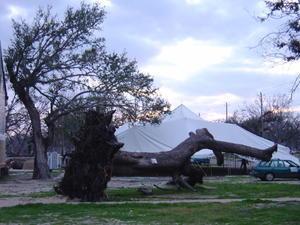Advertisement
Published: March 7th 2006

 Fallen tree with Tent
Fallen tree with Tent
The fallen tree and tent offers a dichotomy of images: new and old, natural and manmade, standing tall and falling tall.Today was a day of extremes. The no-see-ums, or gnats, were out in force, so I looked to be inside. Again, I heard people's stories, talked with several volunteers as well as residents. And, I took another look at the place around me, which I tried to envisioin with lots of full, green trees, green lawns, and carefully crafted flower beds. It was hard given that I still saw lots of debris yet to be cleared. Here are my three main observations for the day.
1. Unorganized organizations is the rule of the day, but change is afoot.
I came across many people the past several days who commented on how disorganized the recovery effort has been, and now that the community is moving towards rebuilding, how this hampers the efforts of all even more. There are at least a few dozen, and probably more, groups offering various types of assistance, ranging from free food and clothing, to "mucking" and roofing. Given the range of volunteer and staff coordination coupled with knowing which groups to go to for what types of assistance, a resident trying to get help may not know which group to turn to. As a result,

 Still Seeing Ruins
Still Seeing Ruins
If you think that the debris and unusable buildings are gone, think again, because there is a lot of clean up to still do in this town.there are various coordination efforts emerging. One effort is the AmeriCorps Community Internet and Office Lab, which includes a job bank, volunteer information and resource center. Another is the Long Term Recovery Team and Pass Recovery, two related groups working to coordinate matching services with needs and identifying the gaps or "unmet needs". I also met with Seth, the AdoptaNeed.org coordinator through AmeriCorps, who explained the long-term game plan and how San Carlos could plug in through this program, including documentation on volunteer hours, money received and spent, and centralizing donation and needs efforts.
2. "I'd like a washer and dryer at my trailer."
Today I took appointments at the Salvation Army tent for case workers to evaluate residents' needs and their readiness for vouchers. This was challenging. I had to learn how to book appointments (about 120 the first day) on a paper calendar, screen people for Pass C (to minimize "double dipping" as Redd the case worker stated), and accommodate the evolving needs of the new staff. Many people calling to get a voucher for the free washer and dryer. At first, I was aghast that people believed they "needed" a washer and dryer when they

 Water Tower
Water Tower
This second Pass Christian water tower was ideally located with the sun setting and adjacent to the open tracks.lived in a FEMA trailer, which technically, they couldn't have unless it was in a shed or some covered structure. Plus, the Barbara, a case worker, cautioned me that some people want to either sell the voucher or the washer and dryer, which had happened the previous day with the free toaster ovens, which were turned back in to the store of purchase for cash (using the liberal return policies for Katrina victims). I had to explain to them that they needed an appointment with a case worker to evaluate their need, and that they needed to bring a lengthy list of paperwork with them to be properly evaluated. And, to top off the difficulty I have with the deep southern accent, a train seemed to go by every 25-30 minutes, lengthening my time on the phone while I waited for the full minute for the train to pass by the tent. I really admire people like Barbara, who lost her home in Pass C, is living with her brother in Biloxi, yet shows up to work at the Salvation Army every morning with a cheery voice, big smile, and hearty "thank you" to me for my volunteer time. I

 The MRE
The MRE
Well, here you have it...the contents of my vegetarian MRE. As you can see, there are plenty of plastic packages filled with premade, preserved food. You really haven't lived until you've eaten an MRE.was happy to head off to lunch with my friend Lou and hear more people's stories at the FEMA meal tent in The Village.
3. MRE's ... not your average GI Joe meal.
For dinner tonight, we ate MRE's (Meals Ready-to-Eat)...not because of their reputation for haute cuisine, but because Wilma and I wanted to make MRE handbags. So, Lou, being the good sport that he is, indulged us. We prepared our meals (which consisted of figuring out how to open the various plastic pouches without tearing the bags to bits), heating them using a chemical heating element and water, and eating them, or as much as we could stomach. Good thing I prepared some fresh cooked veggies and rice pilaf to accompany the MRE. See my photo of my full compliment of "food", of which I ate very little.
Advertisement
Tot: 0.212s; Tpl: 0.011s; cc: 9; qc: 50; dbt: 0.1144s; 1; m:domysql w:travelblog (10.17.0.13); sld: 2;
; mem: 1.1mb

 Fallen tree with Tent
Fallen tree with Tent
 Still Seeing Ruins
Still Seeing Ruins
 Water Tower
Water Tower
 The MRE
The MRE